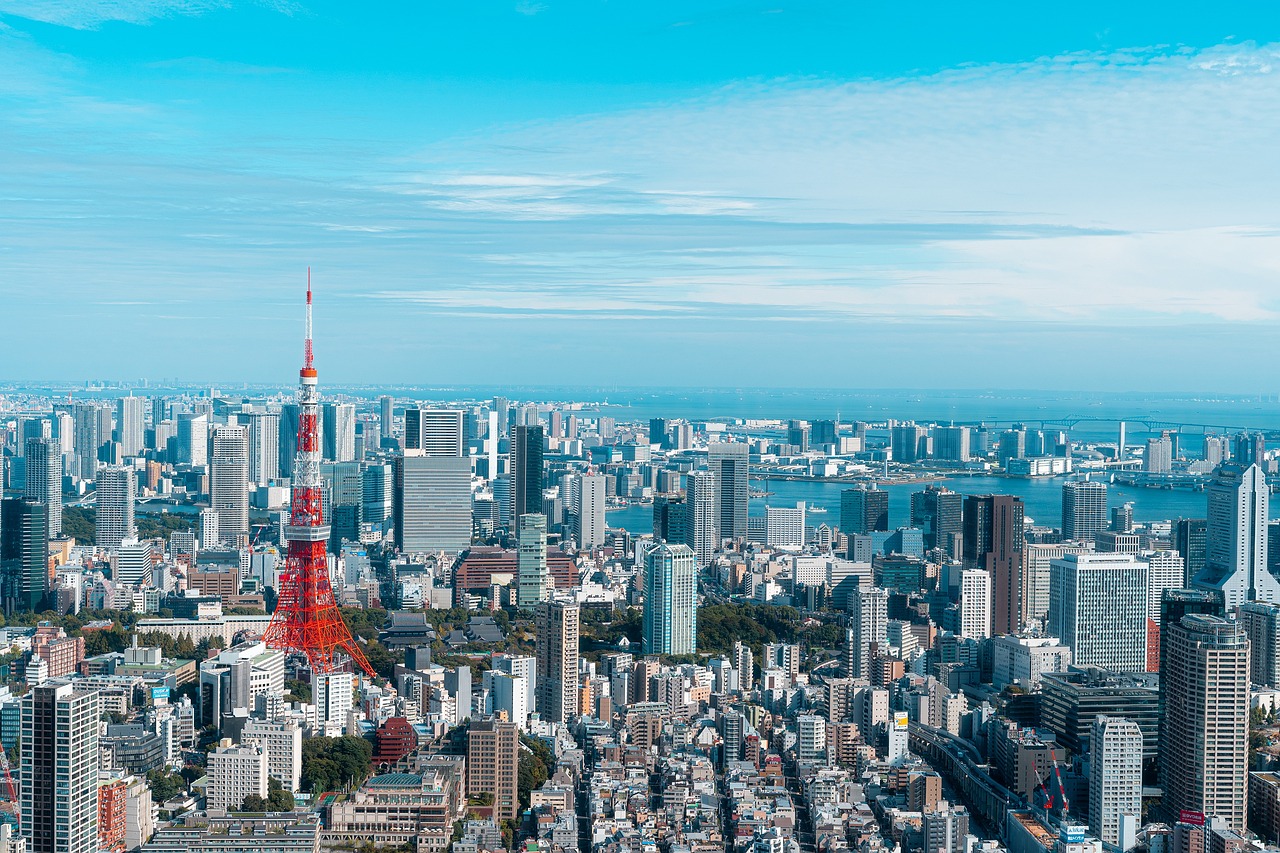はじめに
こんにちは!今日は、英語の多読練習にぴったりな東京の歴史についてお話しします。東京は日本の首都であり、世界でも有数の大都市です。その歴史は非常に興味深く、様々な変遷を経て現在の姿に至っています。この記事では、東京の始まりから現代までの歴史を詳しく見ていきましょう。
Hello! Today, I will talk about the history of Tokyo, which is perfect for extensive reading practice in English. Tokyo is the capital of Japan and one of the world’s largest cities. Its history is incredibly fascinating, having gone through various transformations to become what it is today. In this article, we will explore the history of Tokyo from its beginnings to the present day.
東京の始まり
東京は、もともと江戸という名前でした。江戸は16世紀後半に小さな漁村として始まりました。徳川家康が1603年に江戸幕府を開いたことで、江戸は日本の政治の中心地となりました。江戸時代には、江戸城が建てられました。この城は徳川幕府の中心であり、政治の要所となりました。江戸城は壮大な構造を持ち、その周りには広大な庭園が広がっていました。
Tokyo was originally called Edo. Edo began as a small fishing village in the late 16th century. When Tokugawa Ieyasu established the Edo Shogunate in 1603, Edo became the political center of Japan. During the Edo period, Edo Castle was built. This castle became the center of the Tokugawa Shogunate and a political hub. Edo Castle had a grand structure, surrounded by extensive gardens.
江戸の発展
江戸は、商業や文化の中心地としても発展しました。商人や職人が集まり、町は賑わいを見せました。江戸時代の終わりには、江戸はすでに100万人以上の人口を持つ大都市となっていました。多くの文化施設や商業施設が立ち並び、人々は豊かな生活を楽しんでいました。江戸時代の文化は、浮世絵や歌舞伎、茶道など、多くの面で花開きました。
Edo also developed as a commercial and cultural center. Merchants and artisans gathered, and the town flourished. By the end of the Edo period, Edo had already become a major city with a population of over one million. Many cultural and commercial facilities lined the streets, and people enjoyed a rich lifestyle. Edo period culture flourished in many aspects, including ukiyo-e, kabuki, and tea ceremonies.
明治時代の変革
1868年、明治維新が起こり、日本は大きく変わりました。この時、江戸は東京と改名されました。東京は「東の都」という意味で、新しい首都として選ばれました。明治天皇が東京に移り住んだことで、東京はさらに発展していきました。明治時代には、西洋の技術や文化が急速に取り入れられました。鉄道や電信などのインフラが整備され、東京は近代的な都市へと変貌を遂げました。
In 1868, the Meiji Restoration occurred, and Japan underwent significant changes. At this time, Edo was renamed Tokyo. Tokyo means “Eastern Capital” and was chosen as the new capital. With Emperor Meiji moving to Tokyo, the city continued to grow. During the Meiji era, Western technology and culture were rapidly adopted. Infrastructure such as railways and telegraphs were developed, and Tokyo transformed into a modern city.
教育と文化の進展
教育制度の改革も行われました。東京大学が設立され、多くの学者や学生が集まりました。東京は日本の知識と文化の中心地としての地位を確立しました。文学や芸術もこの時期に発展し、多くの著名な作家や芸術家が東京で活躍しました。東京の近代化は、建築や都市計画にも反映され、新しい建物や街並みが次々と登場しました。
Education reforms were also implemented. The University of Tokyo was established, attracting many scholars and students. Tokyo established itself as the center of knowledge and culture in Japan. Literature and art also flourished during this period, with many notable writers and artists active in Tokyo. Tokyo’s modernization was reflected in its architecture and urban planning, with new buildings and streetscapes emerging.
大正時代の発展
1912年から1926年までの大正時代は、東京のさらなる発展と変革の時期でした。この時期には、民主主義や自由主義の思想が広まり、社会が大きく変わりました。新しい文化やファッションが登場し、都市の雰囲気も変わっていきました。東京では、映画やジャズ音楽などの西洋文化が人気を集めました。カフェやダンスホールがオープンし、多くの若者が集まりました。
The Taisho period, from 1912 to 1926, was a time of further development and transformation for Tokyo. During this period, democratic and liberal ideas spread, and society underwent significant changes. New cultures and fashions emerged, and the atmosphere of the city also changed. In Tokyo, Western culture such as movies and jazz music became popular. Cafes and dance halls opened, attracting many young people.
関東大震災と復興
しかし、1923年には関東大震災が発生し、東京は大きな被害を受けました。多くの建物が倒壊し、火災が発生しました。しかし、その後の復興計画により、東京は再び立ち直り、さらに発展していきました。この災害からの復興は、都市のインフラを再構築し、現代の東京の基盤を築く重要な機会となりました。
However, in 1923, the Great Kanto Earthquake struck, causing significant damage to Tokyo. Many buildings collapsed, and fires broke out. However, through subsequent reconstruction plans, Tokyo was able to recover and continue to develop. This reconstruction was an important opportunity to rebuild the city’s infrastructure and lay the foundation for modern Tokyo.
昭和時代の激動
1926年から1989年までの昭和時代は、東京にとって激動の時代でした。この時期には、第二次世界大戦や戦後の復興、そして高度経済成長期が含まれます。第二次世界大戦中、東京は度重なる空襲に見舞われました。1945年の東京大空襲では、多くの建物が破壊され、多くの人々が犠牲になりました。戦後、東京は驚異的なスピードで復興し、新しい都市として生まれ変わりました。
The Showa period, from 1926 to 1989, was a tumultuous time for Tokyo. This period included World War II, post-war reconstruction, and the period of rapid economic growth. During World War II, Tokyo was subjected to repeated air raids. In the Tokyo air raids of 1945, many buildings were destroyed, and many lives were lost. After the war, Tokyo was rebuilt at an astonishing speed and was reborn as a new city.
東京オリンピックと高度経済成長
戦後の復興期には、東京オリンピックの開催が大きな転機となりました。1964年の東京オリンピックは、戦後の復興と日本の経済成長を象徴するイベントでした。このオリンピックを機に、東京はさらに国際的な都市としての地位を確立しました。また、この時期には、高速道路や新幹線などのインフラが整備され、都市の利便性が大幅に向上しました。
During the post-war reconstruction period, the Tokyo Olympics marked a major turning point. The 1964 Tokyo Olympics was an event that symbolized post-war reconstruction and Japan’s economic growth. With this Olympics, Tokyo further established its status as an international city. Additionally, during this period, infrastructure such as expressways and the Shinkansen were developed, greatly improving the city’s convenience.
現代の東京
現在、東京は世界でも有数の大都市となっています。経済、文化、技術の中心地であり、多くの観光客が訪れます。東京スカイツリーや浅草寺など、見どころもたくさんあります。近代的なビル群と伝統的な文化が共存する魅力的な都市です。東京は常に進化し続けており、新しい技術やインフラの整備で、さらに便利で住みやすい都市へと変貌を遂げています。
Today, Tokyo is one of the world’s largest cities. It is a center of economy, culture, and technology, attracting many tourists. There are many sights to see, like Tokyo Skytree and Sensoji Temple. It’s a fascinating city where modern skyscrapers coexist with traditional culture. Tokyo is constantly evolving, transforming into an even more convenient and livable city with the development of new technologies and infrastructure.
以上が東京の歴史の概要です。東京は常に変化し続ける都市であり、その歴史を知ることで、現在の東京の姿がより深く理解できるでしょう。
These are the highlights of Tokyo’s history. Tokyo is a city that constantly changes, and understanding its history allows for a deeper appreciation of its current state.

コメント